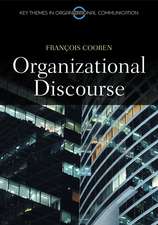Intonation in Text and Discourse: Beginnings, Middles and Ends: Studies in Language and Linguistics
Autor Anne Wichmannen Limba Engleză Paperback – mar 2000
Intonation in Text and Discourse describes the way in which speech melody, or intonation, is used to signal the structure of spoken texts. It examines the role of intonation in clarifying the relationship between successive utterances, from close cohesive ties ('middles') to major breaks for a new topic ('ends' and 'beginnings').
The book is concerned chiefly with the intonational structuring of read or prepared monologue, but also devotes a chapter to current developments in the analysis of intonation in conversation. It describes not only how intonation is used to organise systematic turn-taking but also how it can signal greater or lesser degrees of co-operativeness. It addresses finally the complex issue of attitudinal intonation - the elusive 'tone of voice'.
The first book on discourse intonation to deal with such a wide variety of naturally-occurring spoken data, Intonation in Text and Discourse will be of great interest to students, lecturers and researchers of intonation and all aspects of spoken discourse.
| Toate formatele și edițiile | Preț | Express |
|---|---|---|
| Paperback (1) | 561.11 lei 6-8 săpt. | |
| Taylor & Francis – mar 2000 | 561.11 lei 6-8 săpt. | |
| Hardback (1) | 1000.27 lei 6-8 săpt. | |
| Taylor & Francis – 7 dec 2016 | 1000.27 lei 6-8 săpt. |
Preț: 561.11 lei
Preț vechi: 660.12 lei
-15% Nou
Puncte Express: 842
Preț estimativ în valută:
107.37€ • 112.40$ • 88.84£
107.37€ • 112.40$ • 88.84£
Carte tipărită la comandă
Livrare economică 05-19 aprilie
Preluare comenzi: 021 569.72.76
Specificații
ISBN-13: 9780582234741
ISBN-10: 0582234743
Pagini: 172
Dimensiuni: 156 x 234 x 11 mm
Greutate: 0.25 kg
Ediția:1
Editura: Taylor & Francis
Colecția Routledge
Seria Studies in Language and Linguistics
Locul publicării:Oxford, United Kingdom
ISBN-10: 0582234743
Pagini: 172
Dimensiuni: 156 x 234 x 11 mm
Greutate: 0.25 kg
Ediția:1
Editura: Taylor & Francis
Colecția Routledge
Seria Studies in Language and Linguistics
Locul publicării:Oxford, United Kingdom
Notă biografică
Anne Wichmann is a Reader in Speech and Language at the University of Central Lancashire.
Descriere
A printed text includes punctuation marks, capitalisation, paragraphs, headings and sub-headings to help the reader to understand how the words are organised into sentences, and sentences are organised into a coherent text. In a spoken text, this typographical information is absent. So how do readers and speakers provide equivalent information to the listener? Intonation in Text and Discourse describes the way in which speech melody, or intonation, is used to signal the structure of spoken texts, and it is the first text on discourse intonation to explore a wide variety of naturally-occurring spoken data.
Cuprins
Author's acknowledgements
Publisher's acknowledgements
Introduction
CHAPTER ONE:
CHAPTER TWO:
Analysing spoken discourse
1.1 A historical perspective
1.2 Prosodic resources
1.2.1 Intonation
1.2.2 Models of intonation
1.2.2.1 Pitch
1.2.2.2 Phrasing 12
1.2.2.3 Phonetic realisation of
phonological categories 12
1.2.3 Instrumental and auditory analysis 12
1.3 Modelling spoken discourse 13
1.3.1 Models of text and discourse structure 15
1.3.1.1 Propositional models 15
1.3.1.2 Cognitive models 16
1.3.1.3 Formal models 17
1.3.2 Modelling conversational interaction 18
1.4 Speaking styles 19
1.4.1 Reading 20
1.4.2 Unscripted speech 21
1.4.3 Other speaking styles 21
1.4.4 Conclusion 22
1.5 Summary 22
Beginnings
2.1 Paragraph intonation in oral reading:
4 case studies
24
25
v
CONTENTS
2.1.1 Case 1: A news summary 25
2.1.2 Case 2: A news report 27
2.1.3 Case 3: A short story 28
2.1.3.1 Topics or paragraphs? 30
2.1.3.2 Spoken vs. written paragraphs 30
2.1.4 Case 4: Children's oral reading 33
2.2 Titles, headlines and openers: the 'citation
contour' as a topic marker 35
2.2.1 Topic marking in read speech 36
2.2.2 Topic marking in spontaneous speech 38
2.3 Phonetic issues surrounding initiality 41
2.3.1 How high is high? 41
2.3.1.1 Relative pitch height 41
2.3.1.2 Individual pitch preferences 42
2.3.2 The role of timing 43
2.3.2.1 Segmental and prosodic
factors affecting peak timing 44
2.3.2.2 The effect of discourse on
peak timing 44
2.3.2.3 Theoretical implications:
association vs. alignment 45
2.4 Summary 46
CHAPTER THREE: Ends 49
3.1 Coming to the end: evidence from the SEC 50
3.1.1 Falling tones 50
3.1.2 Early closure 50
3.1.2.1 Utterance-final rises 50
3.1.2.2 Utterance-internal falls 51
3.2 What kind of falling tones are there? 53
3.2.1 High and low falls 53
3.2.2 Tails and endpoints 55
3.2.3 Finality and discourse structure 58
3.2.4 High and low falls in the SEC 59
3.2.4.1 Inconsistencies: evidence for the
role of the speaker's range 62
3.3 'Cadences': melodic closure 63
3.3.1 Common cadences 64
3.3.2 Stylistic variation 65
3.3.2.1 The journalistic 'flourish' 66
3.3.2.2 The liturgical 'drop' 67
3.4 Perception of falls - experimental evidence 69
3.5 Summary 71
CHAPTER FOUR: Cohesion 74
4.1 Cohesion and intonation 74
vi
CHAPTER FIVE:
CONTENTS
4.1.1 Intonation and information structure:
accenting and de-accenting 74
4.1.2 Cohesion and 'onset depression' 75
4.2 Cohesion in the SEC 77
4.2.1 Phrase and clause boundaries:
pitch depression inside sentences 78
4.2.1.1 Non-restrictive postmodification 78
4.2.1.2 Co-ordination 81
4.2.2 Undoing early closure 83
4.2.3 Cohesive links between sentences 84
4.2.4 Conclusion 85
4.3 Intonational parallelism 85
4.3.1 Some common parallelisms 85
4.3.2 Models of tonal parallelism 86
4.3.3 Reconciling models with corpus data 87
4.3.3.1 Parallelism between
different tones
4.3.3.2 Parallelism between
non-adjacent tone groups
4.3.4 Conclusion
4.4 Parenthesis - a reassessment
4.4.1 The intonation of parenthesis
4.4.2 Defining parenthesis
4.5 Summary
Paragraph intonation - local and global
pitch range in discourse
5.1 Local events or global trends?
5.1.1 Models of sentence declination
5.1.2 Paragraph declination
5.2 Models of paragraph intonation
5.2.1 'Paratones'
5.2.2 'Supradeclination'
5.3 Looking for supradeclination in natural data:
some obscuring factors
5.3.l The effect of information structure on
87
89
93
93
94
98
100
102
102
103
105
105
105
107
108
sentence declination 108
5.3.2 Evidence for supradeclination 112
5.3.2.1 Declination across sentence
onsets (the first accented syllable
in each sentence) 113
5.3.2.2 Declination across FO maxima:
the highest FO peak in each
sentence 113
5.3.2.3 Declination across the mean:
the mean FO for each sentence 115
vii
CONTENTS
5.4 Pitch scaling and discourse status 116
5.5 Reconsidering paragraph declination:
a composite view 118
5.6 Summary 121
CHAPTER SIX: Intonation in conversation: structure and
meaning 123
6.1 A theoretical framework 123
6.2 Semantic framing I topic structuring:
the units of discourse and the relationship
between them 126
6.2.1 The 'spoken sentence' 126
6.2.2 Meaning relations between 'spoken
sentences' 127
6.2.3 Meaning relations between
discourse moves 130
6.2.4 Summary 131
6.3 Turn-taking 132
6.3.1 Smooth turn-taking 132
6.3.2 Topic control: creating conversational
space 133
6.3.2.1 Non-competitive talk 133
6.3.2.2 Competitive talk 134
6.3.2.3 Informal conversation:
suspending turn-taking 136
6.3.3 Communication checks 138
6.4 Co-operation, affiliation, disaffiliation 139
6.4.1 Pitch modification 140
6.4.1.1 Non-supportive backchannels 140
6.4.1.2 Speaker-hearer orientation: the
notion of pitch concord 141
6.5 Summarising intonation resources in
conversation 143
6.6 Attitudinal intonation: interaction and
intonational meaning 144
Appendix I 149
Appendix II 151
References 152
Index
Publisher's acknowledgements
Introduction
CHAPTER ONE:
CHAPTER TWO:
Analysing spoken discourse
1.1 A historical perspective
1.2 Prosodic resources
1.2.1 Intonation
1.2.2 Models of intonation
1.2.2.1 Pitch
1.2.2.2 Phrasing 12
1.2.2.3 Phonetic realisation of
phonological categories 12
1.2.3 Instrumental and auditory analysis 12
1.3 Modelling spoken discourse 13
1.3.1 Models of text and discourse structure 15
1.3.1.1 Propositional models 15
1.3.1.2 Cognitive models 16
1.3.1.3 Formal models 17
1.3.2 Modelling conversational interaction 18
1.4 Speaking styles 19
1.4.1 Reading 20
1.4.2 Unscripted speech 21
1.4.3 Other speaking styles 21
1.4.4 Conclusion 22
1.5 Summary 22
Beginnings
2.1 Paragraph intonation in oral reading:
4 case studies
24
25
v
CONTENTS
2.1.1 Case 1: A news summary 25
2.1.2 Case 2: A news report 27
2.1.3 Case 3: A short story 28
2.1.3.1 Topics or paragraphs? 30
2.1.3.2 Spoken vs. written paragraphs 30
2.1.4 Case 4: Children's oral reading 33
2.2 Titles, headlines and openers: the 'citation
contour' as a topic marker 35
2.2.1 Topic marking in read speech 36
2.2.2 Topic marking in spontaneous speech 38
2.3 Phonetic issues surrounding initiality 41
2.3.1 How high is high? 41
2.3.1.1 Relative pitch height 41
2.3.1.2 Individual pitch preferences 42
2.3.2 The role of timing 43
2.3.2.1 Segmental and prosodic
factors affecting peak timing 44
2.3.2.2 The effect of discourse on
peak timing 44
2.3.2.3 Theoretical implications:
association vs. alignment 45
2.4 Summary 46
CHAPTER THREE: Ends 49
3.1 Coming to the end: evidence from the SEC 50
3.1.1 Falling tones 50
3.1.2 Early closure 50
3.1.2.1 Utterance-final rises 50
3.1.2.2 Utterance-internal falls 51
3.2 What kind of falling tones are there? 53
3.2.1 High and low falls 53
3.2.2 Tails and endpoints 55
3.2.3 Finality and discourse structure 58
3.2.4 High and low falls in the SEC 59
3.2.4.1 Inconsistencies: evidence for the
role of the speaker's range 62
3.3 'Cadences': melodic closure 63
3.3.1 Common cadences 64
3.3.2 Stylistic variation 65
3.3.2.1 The journalistic 'flourish' 66
3.3.2.2 The liturgical 'drop' 67
3.4 Perception of falls - experimental evidence 69
3.5 Summary 71
CHAPTER FOUR: Cohesion 74
4.1 Cohesion and intonation 74
vi
CHAPTER FIVE:
CONTENTS
4.1.1 Intonation and information structure:
accenting and de-accenting 74
4.1.2 Cohesion and 'onset depression' 75
4.2 Cohesion in the SEC 77
4.2.1 Phrase and clause boundaries:
pitch depression inside sentences 78
4.2.1.1 Non-restrictive postmodification 78
4.2.1.2 Co-ordination 81
4.2.2 Undoing early closure 83
4.2.3 Cohesive links between sentences 84
4.2.4 Conclusion 85
4.3 Intonational parallelism 85
4.3.1 Some common parallelisms 85
4.3.2 Models of tonal parallelism 86
4.3.3 Reconciling models with corpus data 87
4.3.3.1 Parallelism between
different tones
4.3.3.2 Parallelism between
non-adjacent tone groups
4.3.4 Conclusion
4.4 Parenthesis - a reassessment
4.4.1 The intonation of parenthesis
4.4.2 Defining parenthesis
4.5 Summary
Paragraph intonation - local and global
pitch range in discourse
5.1 Local events or global trends?
5.1.1 Models of sentence declination
5.1.2 Paragraph declination
5.2 Models of paragraph intonation
5.2.1 'Paratones'
5.2.2 'Supradeclination'
5.3 Looking for supradeclination in natural data:
some obscuring factors
5.3.l The effect of information structure on
87
89
93
93
94
98
100
102
102
103
105
105
105
107
108
sentence declination 108
5.3.2 Evidence for supradeclination 112
5.3.2.1 Declination across sentence
onsets (the first accented syllable
in each sentence) 113
5.3.2.2 Declination across FO maxima:
the highest FO peak in each
sentence 113
5.3.2.3 Declination across the mean:
the mean FO for each sentence 115
vii
CONTENTS
5.4 Pitch scaling and discourse status 116
5.5 Reconsidering paragraph declination:
a composite view 118
5.6 Summary 121
CHAPTER SIX: Intonation in conversation: structure and
meaning 123
6.1 A theoretical framework 123
6.2 Semantic framing I topic structuring:
the units of discourse and the relationship
between them 126
6.2.1 The 'spoken sentence' 126
6.2.2 Meaning relations between 'spoken
sentences' 127
6.2.3 Meaning relations between
discourse moves 130
6.2.4 Summary 131
6.3 Turn-taking 132
6.3.1 Smooth turn-taking 132
6.3.2 Topic control: creating conversational
space 133
6.3.2.1 Non-competitive talk 133
6.3.2.2 Competitive talk 134
6.3.2.3 Informal conversation:
suspending turn-taking 136
6.3.3 Communication checks 138
6.4 Co-operation, affiliation, disaffiliation 139
6.4.1 Pitch modification 140
6.4.1.1 Non-supportive backchannels 140
6.4.1.2 Speaker-hearer orientation: the
notion of pitch concord 141
6.5 Summarising intonation resources in
conversation 143
6.6 Attitudinal intonation: interaction and
intonational meaning 144
Appendix I 149
Appendix II 151
References 152
Index





















